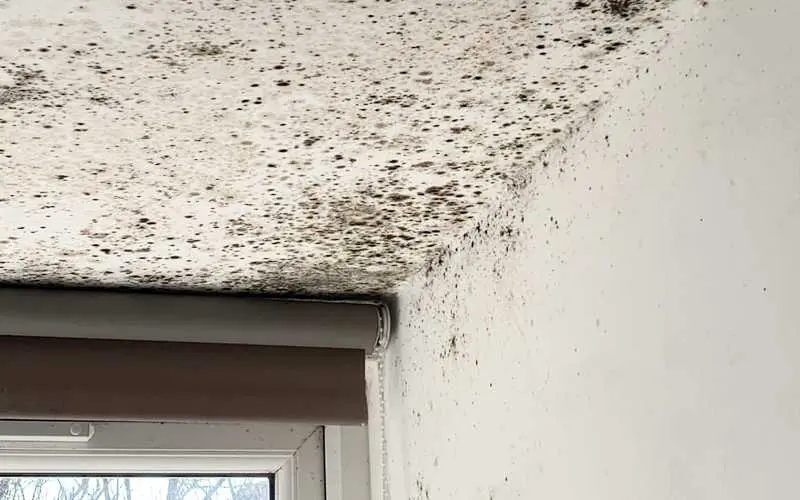Discover the factors behind the formation of mold on your ceiling and explore actionable strategies for prevention. Unravel the mysteries of “Causes of Mold on Ceiling” and safeguard your home from potential issues.

Introduction
Mold growth on the ceiling can be a cause for concern, not only for the aesthetic appeal of your home but also for the potential health risks associated with mold exposure. In this comprehensive guide, we will delve into the various factors contributing to the formation of mold on ceilings. Gain valuable insights into the “Causes of Mold on Ceiling” and empower yourself with effective prevention measures.
Causes of Mold on Ceiling: Unraveling the Mysteries
*1. Excess Moisture: The Primary Culprit
One of the primary causes of mold on the ceiling is excess moisture. This can result from various sources, including roof leaks, plumbing issues, or high humidity levels within the home. Identifying and addressing the source of excess moisture is crucial for effective mold prevention.
*2. Leaky Roofs and Ceilings
Roof leaks are a common contributor to mold growth on ceilings. Damaged or missing shingles, deteriorated flashing, or compromised roof structures can allow water to infiltrate, leading to damp conditions conducive to mold development.
*3. Poor Ventilation
Inadequate ventilation can trap moisture indoors, providing an ideal environment for mold growth. Areas with poor air circulation, such as bathrooms, kitchens, or poorly ventilated attics, are susceptible to mold infestation on ceilings.
*4. Water Damage from Plumbing Issues
Leaking pipes, burst water pipes, or plumbing issues within the ceiling structure can introduce moisture, promoting mold growth. Regular inspection and prompt repair of plumbing systems can mitigate the risk of mold formation.
*5. Condensation Buildup
Condensation occurs when warm, moist air comes into contact with cool surfaces, leading to water droplet formation. Ceilings in poorly insulated or poorly ventilated spaces are prone to condensation, fostering an environment conducive to mold.
Identifying and Addressing the Causes of Mold on Ceiling
Explore each cause in detail and understand effective strategies for addressing and preventing mold growth on ceilings.
1. Excess Moisture: Managing Humidity Levels
Maintain optimal humidity levels within your home, typically between 30% and 50%. Use dehumidifiers in areas prone to moisture buildup and ensure proper ventilation to minimize condensation.
2. Leaky Roofs and Ceilings: Regular Roof Inspections
Schedule regular roof inspections to identify and address any damage promptly. Repair or replace damaged shingles, flashing, or roof structures to prevent water infiltration.
3. Poor Ventilation: Enhancing Air Circulation
Improve ventilation in problematic areas by installing exhaust fans, opening windows, or utilizing air purifiers. Ensure that air circulates freely to reduce the risk of mold growth.
4. Water Damage from Plumbing Issues: Routine Inspections
Regularly inspect plumbing systems for leaks, corrosion, or other issues. Promptly address any plumbing problems to prevent water damage and mold formation.
5. Condensation Buildup: Insulation and Ventilation Improvements
Improve insulation in areas prone to condensation buildup. Enhance ventilation by installing vents, fans, or air exchange systems to reduce the likelihood of condensation on ceilings.
Effective Prevention Strategies
*1. Regular Inspections and Maintenance
Conduct regular inspections of your home’s roof, plumbing, and ventilation systems. Address any issues promptly to prevent the development of conditions favorable to mold growth.
*2. Proactive Repairs
If you identify any signs of water damage, leaks, or mold growth, take immediate action. Proactive repairs can prevent further damage and mitigate the risk of mold proliferation.
*3. Educate and Encourage Good Habits
Educate household members about the importance of maintaining a dry environment. Encourage habits such as using exhaust fans, promptly fixing leaks, and practicing good ventilation practices.
Read too: Understanding the Causes and Solutions for a Crack Between Ceiling and Wall: Navigating Home Woes
Conclusion
Understanding the “Causes of Mold on Ceiling” is the first step toward effective prevention and maintenance of a healthy home environment. By addressing excess moisture, leaks, and ventilation issues, you can create conditions unfavorable to mold growth. Implement the strategies outlined in this guide to safeguard your home and promote a mold-free living space.